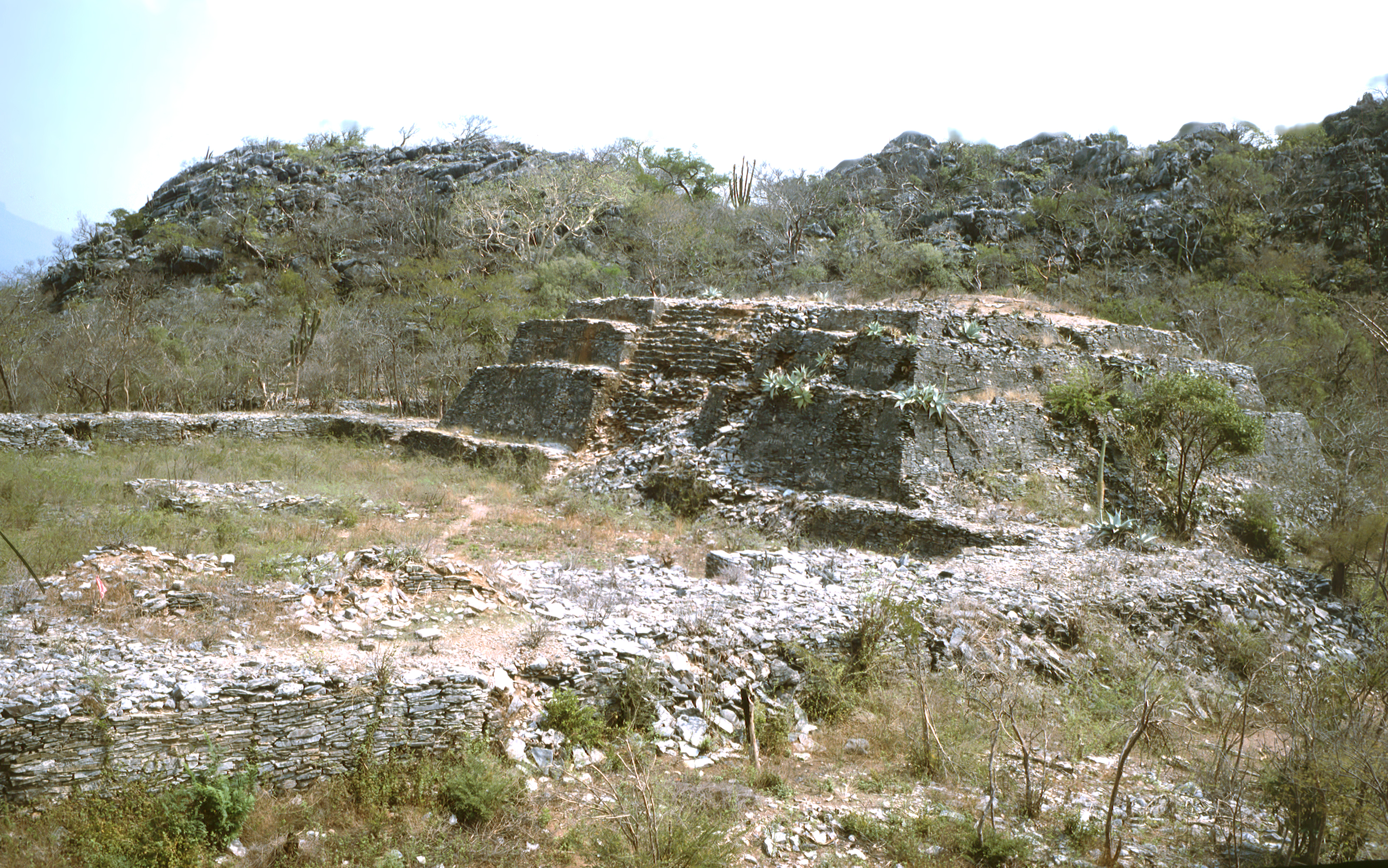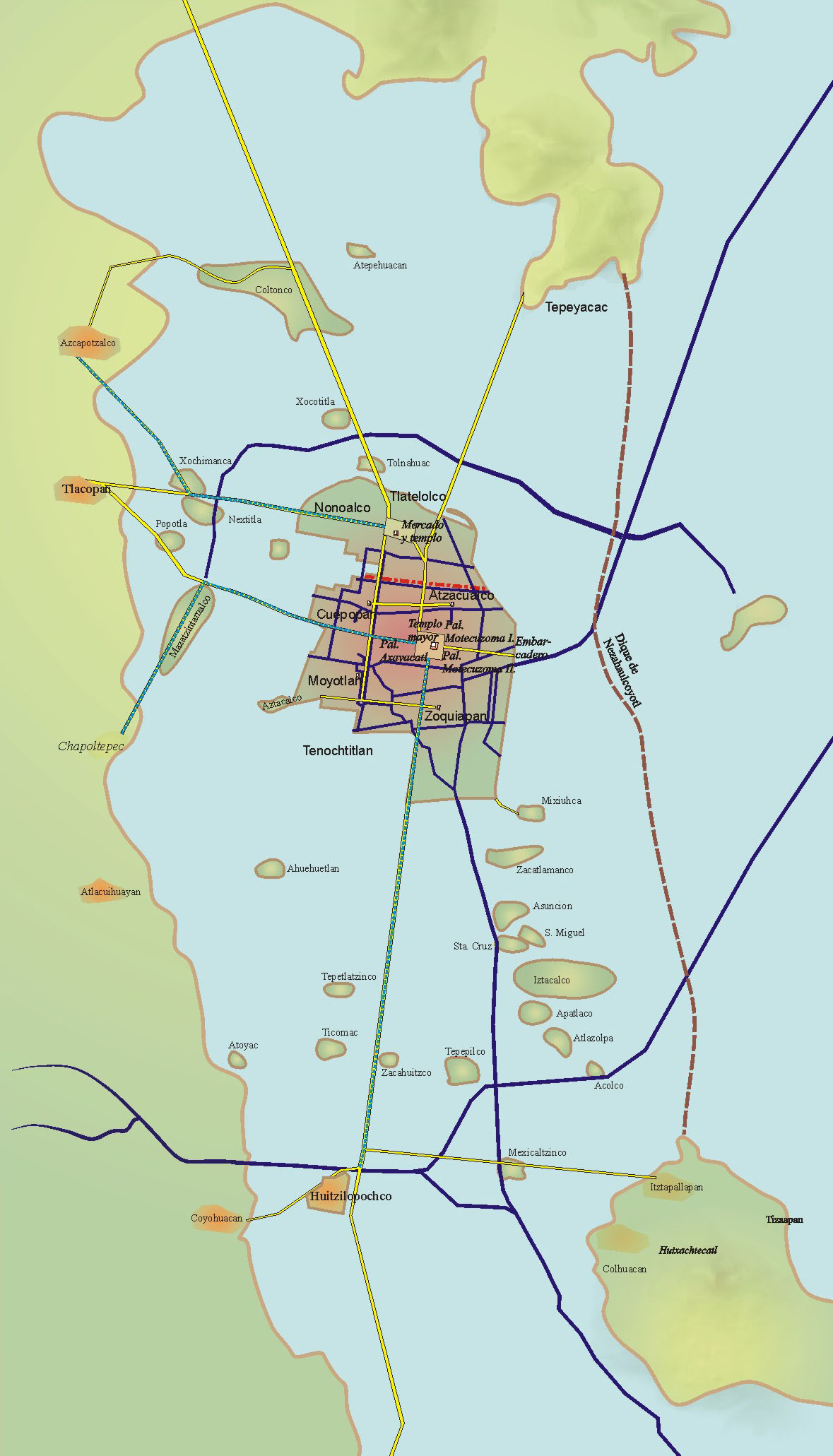|
Guiengola
Guiengola is a Zapotec civilization, Zapotec archeological site located north of Tehuantepec, and southeast of Oaxaca, Oaxaca, Oaxaca city on Federal Highway 190. The visible ruins are located between a hill and a river, each carries the name of Guiengola. The name means "large stone" in the local variant of the Zapotec language. There are two main tombs that have been excavated, and both seem to be family interment sites. Both have front chambers that are for religious idols, while the rear chambers are for the burial of important people. The site also has fortified walls, houses, ballgame fields, other tombs and a very large "palace" with remains of artificial ponds and terraces. In the center of the site are 2 plazas, one lower than the other, and 2 pyramids, one to the east and one to the west. Background The Zapotec civilization had its beginnings in the Valley of Oaxaca, Oaxaca valley in the late 6th century BC. The three branches of the valley were divided between 3 diffe ... [...More Info...] [...Related Items...] OR: [Wikipedia] [Google] [Baidu] |
Tehuantepec
Tehuantepec (, in full, Santo Domingo Tehuantepec) is a city and municipality in the southeast of the Mexican state of Oaxaca. It is part of the Tehuantepec District in the west of the Istmo Region. The area was important in pre-Hispanic period as part of a trade route that connected Central America with what is now the center of Mexico. Later it became a secondary capital of the Zapotec dominion, before it was conquered by the Spanish in the early 16th century. The city is still the center of Zapotec culture in the Isthmus of Tehuantepec and is the second largest in the region. The city is known for its women and their traditional dress, which was adopted by Frida Kahlo. Tehuantepec has a reputation for being a matriarchal society. Women dominate the local markets and are known to taunt men. However, political power is still the domain of men. The city experienced a short economic boom in the early 20th century related to a rail line that was built linking the two ocean ... [...More Info...] [...Related Items...] OR: [Wikipedia] [Google] [Baidu] |
Zapotec Civilization
The Zapotec civilization ( "The People"; 700 BC–1521 AD) is an Indigenous peoples, indigenous Pre-Columbian era, pre-Columbian civilization that flourished in the Valley of Oaxaca in Mesoamerica. Archaeological evidence shows that their culture originated at least 2,500 years ago. The Zapotec archaeological site at the ancient city of Monte Albán has monumental buildings, Mesoamerican ballgame, ball courts, tombs and grave goods, including finely worked gold jewelry. Monte Albán was one of the first major cities in Mesoamerica. It was the center of a Zapotec state that dominated much of the territory which today is known as the Mexican state of Oaxaca. History Zapotec civilization originated in the Y-shaped Valley of Oaxaca, Central Valleys of Oaxaca in the late 6th century BC. The three valleys were divided among three differently-sized societies, separated by "no-man's-land" in the middle. The Oaxaca, Oaxaca, city of Oaxaca much later developed in that area. Archaeolo ... [...More Info...] [...Related Items...] OR: [Wikipedia] [Google] [Baidu] |
Moctezuma II
Moctezuma Xocoyotzin . ( – 29 June 1520), retroactively referred to in European sources as Moctezuma II, and often simply called Montezuma,Other variant spellings include Moctezuma, Motewksomah, Motecuhzomatzin, Moteuczoma, Motecuhzoma, Motēuczōmah and Muteczuma was the ninth emperor of the Aztec Empire (also known as the Mexica Empire), reigning from 1502 or 1503 to 1520. Through his marriage with Queen Tlapalizquixochtzin of Ecatepec, one of his two wives, he was also the king consort of that ''altepetl''. The first contact between the indigenous civilizations of Mesoamerica and Europeans took place during his reign. He was killed during the initial stages of the Spanish conquest of the Aztec Empire when Hernán Cortés, the Spanish conquistador, and his men seized the Aztecs, Aztec capital of Tenochtitlan. During his reign, the Aztec Empire reached its greatest size. Through warfare, Moctezuma expanded the territory as far south as Soconusco, Xoconosco in Chiapas and the ... [...More Info...] [...Related Items...] OR: [Wikipedia] [Google] [Baidu] |
Pre-Columbian
In the history of the Americas, the pre-Columbian era, also known as the pre-contact era, or as the pre-Cabraline era specifically in Brazil, spans from the initial peopling of the Americas in the Upper Paleolithic to the onset of European colonization of the Americas, European colonization, which began with Christopher Columbus's voyage in 1492. This era encompasses the history of Indigenous peoples of the Americas, Indigenous cultures prior to significant European influence, which in some cases did not occur until decades or even centuries after Columbus's arrival. During the pre-Columbian era, many civilizations developed permanent settlements, cities, agricultural practices, civic and monumental architecture, major Earthworks (archaeology), earthworks, and Complex society, complex societal hierarchies. Some of these civilizations had declined by the time of the establishment of the first permanent European colonies, around the late 16th to early 17th centuries, and are know ... [...More Info...] [...Related Items...] OR: [Wikipedia] [Google] [Baidu] |
Monte Albán
Monte Albán is a large pre-Columbian archaeological site in the Santa Cruz Xoxocotlán Municipality in the southern Mexico, Mexican state of Oaxaca (17.043° N, 96.767°W). The site is located on a low mountainous range rising above the plain in the central section of the Valley of Oaxaca, where the latter's northern Etla, eastern Tlacolula, and southern Zimatlán and Ocotlán (Oaxaca), Ocotlán (or Valle Grande (Oaxaca), Valle Grande) branches meet. The present-day state capital Oaxaca City is located approximately east of Monte Albán. The partially excavated civic ceremonial center of the Monte Albán site is situated atop an artificially leveled ridge. It has an elevation of about above mean sea level and rises some from the valley floor, in an easily defensible location. In addition to the monumental core, the site is characterized by several hundred artificial terraces, and a dozen clusters of mounded architecture covering the entire ridgeline and surrounding flanks. Th ... [...More Info...] [...Related Items...] OR: [Wikipedia] [Google] [Baidu] |
Mesoamerican Ballgame
The Mesoamerican ballgame (, , ) was a sport with ritual associations played since at least 1650 BC by the pre-Columbian people of Ancient Mesoamerica. The sport had different versions in different places during the millennia, and a modernized version of the game, ''ulama'', is still played by the indigenous populations in some places.Fox, John (2012)''The ball: discovering the object of the game"'' 1st ed., New York: Harper. . Cf. Chapter 4: "Sudden Death in the New World" about the Ulama game. The rules of the Mesoamerican ballgame are not known, but judging from its descendant, ulama, they were probably similar to racquetball, where the aim is to keep the ball in play. The stone ballcourt goals are a late addition to the game. In the most common theory of the game, the players struck the ball with their hips, although some versions allowed the use of forearms, rackets, bats, or handstones. The ball was made of solid rubber and weighed as much as 9 lbs (4 kg), a ... [...More Info...] [...Related Items...] OR: [Wikipedia] [Google] [Baidu] |
Tenochtitlan
, also known as Mexico-Tenochtitlan, was a large Mexican in what is now the historic center of Mexico City. The exact date of the founding of the city is unclear, but the date 13 March 1325 was chosen in 1925 to celebrate the 600th anniversary of the city. The city was built on an island in what was then Lake Texcoco in the Valley of Mexico. The city was the capital of the expanding Aztec Empire in the 15th century until it was Fall of Tenochtitlan, captured by the Tlaxcaltec and the Spanish in 1521. At its peak, it was the largest city-state, city in the pre-Columbian Americas. It subsequently became a ''Municipalities of Mexico, cabecera'' of the Viceroyalty of New Spain. Today, the ruins of are in the historic center of the Mexican capital. The World Heritage Site of contains what remains of the geography (water, boats, Chinampa, floating gardens) of the Mexica capital. was one of two Mexica (city-states or Polity, polities) on the island, the other being . Etymol ... [...More Info...] [...Related Items...] OR: [Wikipedia] [Google] [Baidu] |
Tlatoani
''Tlahtoāni'' ( , "ruler, sovereign"; plural ' ) is a historical title used by the dynastic rulers of (singular ''āltepētl'', often translated into English as "city-state"), autonomous political entities formed by many pre-Columbian Nahuatl-speaking peoples in the Valley of Mexico during the Postclassic Period. The title of ' (, "great ruler, emperor") was used by the rulers of the Aztec Empire, an alliance between the ''āltepēmeh'' of Tenochtitlan, Tetzcoco, and Tlacopan. Each ''āltepētl'' had its own ''tlahtoāni'' who would concurrently function as its ruler, high priest and commander-in-chief. The ''tlahtoāni'' wielded ultimate authority over all land within the ''āltepētl'', overseeing tribute collection, market activities, temple affairs, and the resolution of judicial disputes. Typically a dynastic ruler hailing from the royal lineage, the ''tlahtoāni'' served for life. However, in certain instances, a council of nobles, elders, and priests could elect a ' ... [...More Info...] [...Related Items...] OR: [Wikipedia] [Google] [Baidu] |
Teotihuacan
Teotihuacan (; Spanish language, Spanish: ''Teotihuacán'', ; ) is an ancient Mesoamerican city located in a sub-valley of the Valley of Mexico, which is located in the State of Mexico, northeast of modern-day Mexico City. Teotihuacan is known today as the site of many of the most architecturally significant Mesoamerican pyramids built in the pre-Columbian Americas, namely the Pyramid of the Sun and the Pyramid of the Moon. Although close to Mexico City, Teotihuacan was not a Mexica (i.e. Aztec) city, and it predates the Aztec Empire by many centuries. At its zenith, perhaps in the first half of the first millennium (1 CE to 500 CE), Teotihuacan was the largest city in the Americas, with a population of at least 25,000, but has been estimated at 125,000 or more, making it at least the sixth-largest city in the world during its epoch. The city covered and 80 to 90 percent of the total population of the valley resided in Teotihuacan. Apart from the pyramids, Teotihu ... [...More Info...] [...Related Items...] OR: [Wikipedia] [Google] [Baidu] |
Sapote
Sapote (; from ) is a term for a soft, edible fruit. The word is incorporated into the common names of several unrelated fruit-bearing plants native to Mexico, Central America and northern parts of South America. Species From Sapotaceae Some, but not all sapotes, come from the family Sapotaceae: * Sapodilla, also called naseberry ('' Manilkara zapota'') is native to Mexico, Guatemala, Nicaragua, Belize, and possibly El Salvador. The Sapotaceae were named after a synonym of this species. * Yellow sapote (''Pouteria campechiana'') is native to Mexico and Central America. * Mamey sapote ('' Pouteria sapota'') is from southern Mexico to northern South America. * Green sapote ('' Pouteria viridis'') is native to lowland southern Mexico. File:Vietnamese Sapote.JPG, '' Manilkara zapota'', , a kind of Vietnamese sapote File:Mamey.jpg, '' Pouteria sapota'', mamey sapote File:Manilkara zapota.jpg, '' Manilkara zapota'', sapodilla File:Canistel-2.jpg, ''Pouteria campechiana'', yellow s ... [...More Info...] [...Related Items...] OR: [Wikipedia] [Google] [Baidu] |







